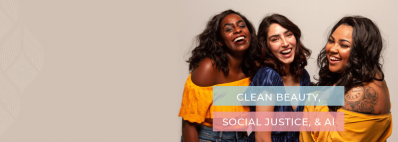Promotional Features
Globally Harmonized Sustainability - Greenwashing and the breakdown
The Environmentalist Movement that dawned more than 50 years ago in the U.S. has evolved into a green and sustainable economic sector. The growth over the years has also led to a rise in concern around company misleading claims, flavored with a bitter accusation of greenwashing and implication of willful deceit to gain profit and position over uninformed consumers. Adjacently, sustainability has fallen to the same suspicious narrative, the broken story, while reconciling information gaps. Here we find consumers and the cosmetic industry share the broken narratives breeding polarization and pervasive mistrust. Let us identify the communication breakdown between Industry and consumers. Companies have shown an increased desire to align sustainable operations and marketing claims, struggling to harmonize and communicate solutions from limited knowledge resources. The United Nations Sustainable Development Goals redirects the narrative for a new conversation.
The communication gap
The US environmental concerns date back to 1960.[1] The conversations grew louder with the first Earth Day in 1970 as 20 million people protested environmental destruction in response to seeing the impacts of the Santa Barbara, CA oil spill shown in the Earth's first photographs from spacecraft Apollo 8.[2] The US government responded to the growing concerns and evidence of finite resources through the Environmental Protection Agency (EPA) formation, an organization tasked to research, monitor, develop baselines, develop standards, and provide financial and technical assistance and training to states. The tasks continue to remain and have evolved through the process. However, the private sector's ability to identify and communicate a baseline leaves an information gap coupled with underdeveloped Industry standards. We are left with the question if companies’ claims mislead or expose the information gap, creating space between their intention and progress. We have one more area of focus before we can answer that question.
“In 1970, millions of Americans concerned about the environment observed the first Earth Day.”[3]
Industry’s struggle to harmonize
Clear communication is essential to progress. Our Industry faces a couple of immediate challenges. The first is the common misconception that green and sustainable have interchangeable meanings creating a knowledge gap to communicate effective messaging throughout the supply chain to market. According to some references, green refers to the activities that provide more efficient use of resources and minimize the harmful impact on the environment than similar products. Sustainable refers to activities that allow a specific problem to be solved without adverse implications in the future.[4] Based on this view of differences, green activities fall under the sustainable umbrella. Secondly, our siloed understanding creates tunnel vision to a broader context outside our Industry. We create new organizations, groups, and standards to collect data with fragmented and unclear baselines for brands to then clearly validate the claims that purposefully align their products. Effective and clear communication that dispels mistrust only exists when there is shared knowledge and understanding. When we look outside our Industry, we find context for globally accepted and harmonized practices with actionable tools and solutions to integrate that mitigate the perception of "greenwashing." Sustainability has many facets spanning efficiencies, social impact, diversity, etc. The United Nations Sustainable Development Goals provide the framework and multifaceted approach to future generations.
Harmonization through the United Nations Sustainable Development Goals – UN SDGs
The United Nations (UN) is an international organization formed after World War II by 51 countries and since then has grown to 193 countries. The UN has 4 main purposes:[5]
- To keep peace throughout the world
- To develop friendly relations among nations
- To help nations work together to improve the lives of poor people, to conquer hunger, disease and illiteracy, and to encourage respect for each other’s rights and freedoms
- To be a center for harmonizing the actions of nations to achieve these goals
In 2015, world leaders from the UN agreed to 17 Global Goals (officially known as the Sustainable Development Goals or SDGs). These goals have the power to create a better world by 2030, to end poverty, fight inequality and address climate change. The goals provide a guide for governments, businesses, civil society and the general public to work together to build a better future for everyone.[6] The UN SDGs, address the interconnected and harmonized global challenges. These challenges crossover into all parts of our lives and business. Since the formation, partnerships with organizations such a B Corporation[7] and the Ellen MacArthur Foundation[8] offer measurement tools to companies to join the movement for a more sustainable future.
We The People' for The Global Goals - A new plan for people and planet has just launched - the UN Global Goals for Sustainable Development.[9]
What are the 17 goals?
Some common sustainability goals discussed among the Beauty Industry are:
- Responsible Consumption and Production – The Circular economy
- Climate Action – Reduction in carbon emissions
- Life Below Water - Reef Safe ingredients and ocean plastic pollution
- Life on Land – Biodiversity, anti-deforestation, pollution
The brief overview of the harmonized goals provides a framework to effectively communicate and align with purposeful and clear areas to support sustainability initiatives.
Through education and resources, programs through the United Nations such as the UN Global Compact help companies further align their operations and reconcile information gaps. Brands can also request Company Sustainability Reports (CSRs) from vendors to help support their understanding of the supply chain and communication to consumers.
Conclusion
Conversations turn into stories, and when there is a communication breakdown, the stories we sometimes tell ourselves are not always accurate or complete. Sometimes, it takes a moment to step outside of ourselves and discomfort to spark curiosity, leading to different ideas and conversations to build communication bridges. At that moment, innovation takes form. As Industry, through our discussions, we can all foster innovation…and that would be UN SDG 9 – Industry, Innovation, and Infrastructure.[10]
More information on involvement with the United Nations.
Watch an interview with Dandi Day CEO, Hayley Hoffman, and United Nations Association regional representatives, Bettina Hausmann and Barry Simon.
Resources
- Data – Global Partnership for Sustainable Development Data https://www.data4sdgs.org/
- Research education, research, policy analysis, and global cooperation – Sustainable Development Solutions Network https://www.unsdsn.org/
- Businesses - UN Global Compact https://www.unglobalcompact.org/
- Individual local involvement – United Nations Association https://wfuna.org/una-directory
- Global citizens - The World Federation of United Nations Associations (WFUNA) http://www.wfuna.org
[1]https://www.epa.gov/history/origins-epa
[2] https://www.bbc.com/future/article/20200420-earth-day-2020-how-an-environmental-movement-was-born; https://www.nasa.gov/multimedia/imagegallery/image_feature_1249.html
[3] https://madison.com/gallery/now/today/history/today-in-history-april-earth-day/collection_0e3512a2-2086-11e7-ac10-b7face762bb7.html
[4] https://www.worldatlas.com/articles/what-is-the-difference-between-green-and-sustainable.html
[5] https://www.un.org/un70/en/content/history/index.html
[6] https://sdgs.un.org/goals
[7] https://bcorporation.net/welcome-sdg-action-manager
[8] https://www.ellenmacarthurfoundation.org/resources/apply/circulytics-measuring-circularity
[9] ‘We The People' for The Global Goals - A new plan for people and planet has just launched - the UN Global Goals for Sustainable Development.






